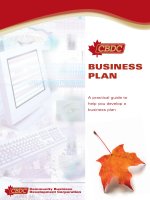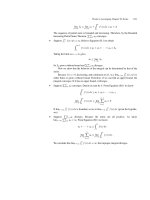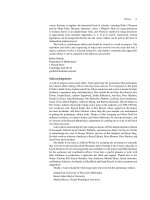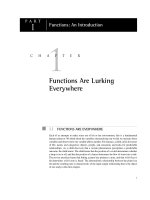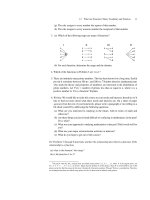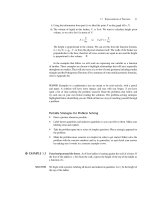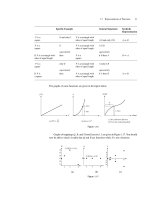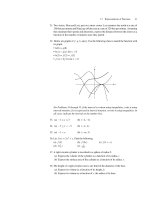Focus on personal finance an active approach to help you develop successful financial skills 4th edition kapoor test bank
Bạn đang xem bản rút gọn của tài liệu. Xem và tải ngay bản đầy đủ của tài liệu tại đây (1.3 MB, 101 trang )
Chapter 02
Money Management Skills
True / False Questions
1.
Money management refers to day-to-day financial activities necessary to manage personal
economic resources while working toward long-term financial security.
True
2.
False
Money management refers to annual financial activities necessary to manage personal economic
resources.
True
3.
The focus of an organized system of financial records is to reduce credit card usage.
True
4.
False
A budget is a record of how a person or family has spent their money.
True
5.
False
False
Programs are available to help low-income older or disabled people who have difficulty
budgeting.
True
False
© 2013 by McGraw-Hill Education. This is proprietary material solely for authorized instructor use. Not
authorized for sale or distribution in any manner. This document may not be copied, scanned, duplicated,
forwarded, distributed, or posted on a website, in whole or part.
6.
In an organized system, credit card records belong in a safe deposit box.
True
7.
In an organized system, birth and marriage certificates belong in a safe deposit box.
True
8.
False
In an organized system, a will belongs in a home file.
True
9.
False
False
Financial records that may need to be referred to on a regular basis should be kept in a safe
deposit box.
True
False
10. In an organized system, account summaries showing the performance results of investments
belong in a computer or online.
True
False
11. Records related to tax returns should be saved for 10 years.
True
False
12. Wills and Social Security data should be kept for up to 10 years.
True
False
© 2013 by McGraw-Hill Education. This is proprietary material solely for authorized instructor use. Not
authorized for sale or distribution in any manner. This document may not be copied, scanned, duplicated,
forwarded, distributed, or posted on a website, in whole or part.
13. The two primary personal financial statements include the personal balance sheet and a credit card
payoff statement.
True
False
14. The current financial position of an individual or family is a common starting point for financial
planning.
True
False
15. Net worth is the amount owed to others.
True
False
16. Current liabilities are the debts you must pay within a short time, usually less than a year.
True
False
17. Most people liquidate their assets to calculate their net worth.
True
False
18. A cash flow statement uses this equation: Assets - Liabilities = Net worth.
True
False
19. A cash flow statement uses this equation: Total cash received during the time period - Cash
outflows during the time period = Cash surplus (deficit).
True
False
© 2013 by McGraw-Hill Education. This is proprietary material solely for authorized instructor use. Not
authorized for sale or distribution in any manner. This document may not be copied, scanned, duplicated,
forwarded, distributed, or posted on a website, in whole or part.
20. When completing a cash flow statement, deductions are subtracted from salary to determine takehome pay.
True
False
21. When completing a cash flow statement, take-home pay less deductions equals salary.
True
False
22. Financial advisers suggest that an emergency fund should cover one to two months of living
expenses.
True
False
23. When creating a budget, it is important to save the amount you have left at the end of the month.
True
False
24. One method to spend more money is to use a direct deposit system from payroll.
True
False
25. One method to save more money is to write a check each payday and deposit it in a savings
account not readily available for regular spending.
True
False
Multiple Choice Questions
© 2013 by McGraw-Hill Education. This is proprietary material solely for authorized instructor use. Not
authorized for sale or distribution in any manner. This document may not be copied, scanned, duplicated,
forwarded, distributed, or posted on a website, in whole or part.
26. Money management refers to
A. Preparing personal financial statements.
B. Day-to-day financial activities.
C. Trade-offs that occur with financial decisions.
D. Storing financial records for easy access.
E. Spending money on current living expenses.
27. Which of the following is NOT a component of money management?
A. Storing personal financial records to document business transactions and legal matters.
B. Creating personal financial statements to measure and assess financial position and progress.
C. Creating a budget.
D. None of these are components of money management.
E. Storing personal financial records, creating personal financial statements, and creating a budget
are all components of money management.
28. A home file should be used for storing
A. All financial documents and records.
B. Financial records for current needs.
C. Documents that require maximum security.
D. Obsolete financial documents.
E. Records that are difficult to replace.
© 2013 by McGraw-Hill Education. This is proprietary material solely for authorized instructor use. Not
authorized for sale or distribution in any manner. This document may not be copied, scanned, duplicated,
forwarded, distributed, or posted on a website, in whole or part.
29. Which of the following financial documents would most likely be stored in a safe deposit box?
A. W-2 forms
B. Personal financial statements
C. Warranties
D. Marriage certificates
E. Checking account statements
30. Which of the following is most correct?
A. A warranty belongs in a safe deposit box.
B. A birth certificate should be kept in a personal computer system.
C. Tax records belong in a home file.
D. A plan for effective budgeting belongs in your safe deposit box.
E. Adoption papers belong in a home file.
31. Which of the following is most correct?
A. Rare coins and stamps belong in a safe deposit box.
B. A birth certificate should be kept in a personal computer system.
C. W-2s for tax records belong in a safe deposit box.
D. A plan for effective budgeting belongs in your safe deposit box.
E. Adoption papers belong in a home file.
© 2013 by McGraw-Hill Education. This is proprietary material solely for authorized instructor use. Not
authorized for sale or distribution in any manner. This document may not be copied, scanned, duplicated,
forwarded, distributed, or posted on a website, in whole or part.
32. A broker statement is an example of a(n) ____________ record.
A. investment
B. insurance
C. estate planning
D. tax
E. consumer purchase
33. The number of personal financial records a household has to organize may seem overwhelming.
How long should you keep copies of your tax returns?
A. Until you receive your refund
B. Until the end of the current year
C. Three years
D. Seven years
E. Permanently
34. The number of personal financial records a household has to organize may seem overwhelming.
How long should you keep documents relating to the purchase of real estate?
A. Until the mortgage is paid off
B. Until you move out of the house
C. Three years
D. Seven years
E. Indefinitely
© 2013 by McGraw-Hill Education. This is proprietary material solely for authorized instructor use. Not
authorized for sale or distribution in any manner. This document may not be copied, scanned, duplicated,
forwarded, distributed, or posted on a website, in whole or part.
35. How long should you keep documents relating to investments?
A. No need to since the broker probably has a copy.
B. As long as you own them.
C. Seven years.
D. Ten years.
E. Permanently.
36. How long should you keep your most current will?
A. No need to keep it since your lawyer probably has a photocopy.
B. One year.
C. Three years.
D. Seven years.
E. Permanently.
37. The main purposes of personal financial statements are to
A. Report your current financial position.
B. Measure your progress toward financial goals.
C. Maintain information about your financial activities.
D. Provide data for preparing tax forms or applying for credit.
E. These are all correct.
© 2013 by McGraw-Hill Education. This is proprietary material solely for authorized instructor use. Not
authorized for sale or distribution in any manner. This document may not be copied, scanned, duplicated,
forwarded, distributed, or posted on a website, in whole or part.
38. Which of the following are considered to be the primary personal financial statements?
A. Budget and credit card statements
B. Personal balance sheet and cash flow statement
C. Checkbook and budget
D. Tax returns
E. Bank statement and savings passbook
39. A personal balance sheet presents
A. Amounts budgeted for spending.
B. Income and expenses for a period of time.
C. Earnings on savings and investments.
D. Items owned and amounts owed.
E. Family financial goals.
40. The current financial position of an individual or family is best presented with the use of a
A. Budget.
B. Cash flow statement.
C. Balance sheet.
D. Bank statement.
E. Time value of money report.
© 2013 by McGraw-Hill Education. This is proprietary material solely for authorized instructor use. Not
authorized for sale or distribution in any manner. This document may not be copied, scanned, duplicated,
forwarded, distributed, or posted on a website, in whole or part.
41. Another name for a statement of financial position is a
A. Balance sheet.
B. Bank statement.
C. Budget.
D. Cash flow statement.
E. Time value of money report.
42. The statement that includes liquid assets, real estate, personal possessions, and investment assets
is known as a
A. Personal balance sheet.
B. Bank statement.
C. Budget.
D. Cash flow statement.
E. Time value of money report.
43. Items with monetary value are referred to as
A. Liabilities.
B. Variable expenses.
C. Net worth.
D. Income.
E. Assets.
© 2013 by McGraw-Hill Education. This is proprietary material solely for authorized instructor use. Not
authorized for sale or distribution in any manner. This document may not be copied, scanned, duplicated,
forwarded, distributed, or posted on a website, in whole or part.
44. Which of the following is NOT a liquid asset?
A. Savings/money market accounts
B. Cash value of life insurance
C. Checking account balance
D. Coins in a jar at home
E. Retirement investments
45. When creating a personal balance sheet, which of the following is a real estate asset?
A. Cash value of life insurance
B. Vacation property
C. Possessions in your home
D. Investments for a dream home
E. Mutual funds
46. When creating a personal balance sheet, which of the following is considered to be a personal
possession asset?
A. A five-year-old television set
B. A home
C. Cash in a checking account
D. Retirement investments
E. Vacation property
© 2013 by McGraw-Hill Education. This is proprietary material solely for authorized instructor use. Not
authorized for sale or distribution in any manner. This document may not be copied, scanned, duplicated,
forwarded, distributed, or posted on a website, in whole or part.
47. When creating a personal balance sheet, which of the following is an investment asset?
A. Cash value of life insurance
B. Checking account
C. Possessions in your home
D. Retirement account
E. Vacation property
48. When creating a personal balance sheet, which of the following is a current liability?
A. Checking account
B. Net worth
C. Student loan
D. Money your sister owes you in two years
E. Charge account balance
49. The amount you would have if everything of value would be sold and all debts would be paid in
full is called your
A. Net assets.
B. Net worth.
C. Total liabilities.
D. Total income.
E. Budgeted expenses.
© 2013 by McGraw-Hill Education. This is proprietary material solely for authorized instructor use. Not
authorized for sale or distribution in any manner. This document may not be copied, scanned, duplicated,
forwarded, distributed, or posted on a website, in whole or part.
50. The equation to calculate net worth is
A. Assets - Cash outflows = Net worth.
B. Cash inflows - Liabilities = Net worth.
C. Cash inflows - Cash outflows = Net worth.
D. Assets - Liabilities = Net worth.
E. Cash inflows + Liabilities = Net worth.
51. The inability to pay debts when they are due is called
A. Liabilities.
B. Insolvency.
C. Net worth.
D. Cash flow.
E. Liquid assets.
52. Which of the following situations describes a person who could be insolvent?
A. Assets $56,000; annual expenses $60,000
B. Assets $78,000; net worth $22,000
C. Liabilities $45,000; net worth $6,000
D. Assets $40,000; liabilities $45,000
E. Annual cash inflows $45,000; liabilities $50,000
© 2013 by McGraw-Hill Education. This is proprietary material solely for authorized instructor use. Not
authorized for sale or distribution in any manner. This document may not be copied, scanned, duplicated,
forwarded, distributed, or posted on a website, in whole or part.
53. All of the following are ways that households can increase their net worth except
A. Increase their savings.
B. Reduce spending.
C. Increase value of investments.
D. Reduce amounts owed.
E. Increase their debt ratio.
54. Which of the following will increase the net worth of a household?
A. Decrease saving by $50 per month
B. Increase the amount borrowed for major purchases
C. Decrease spending by $5 per day
D. Invest in possessions whose values do not increase
E. Keep an extra $100 in a checking account instead of a savings account
55. Which of the following is a cash inflow?
A. Mail rent check
B. Buy groceries
C. Make a loan payment
D. Receive a paycheck
E. Pay medical expenses
© 2013 by McGraw-Hill Education. This is proprietary material solely for authorized instructor use. Not
authorized for sale or distribution in any manner. This document may not be copied, scanned, duplicated,
forwarded, distributed, or posted on a website, in whole or part.
56. Which of the following appears on a cash flow statement?
A. Assets
B. Payments for variable expenses
C. Net worth
D. Liabilities
E. Investments
57. Which of the following appears on a cash flow statement?
A. Home value
B. Loan payment
C. Net worth
D. Balance of mortgage
E. Cash value of life insurance
58. Financial experts recommend a monthly savings ratio of at least ____ of gross income.
A. 0%
B. 5-10%
C. 20%
D. 25-35%
E. 50%
© 2013 by McGraw-Hill Education. This is proprietary material solely for authorized instructor use. Not
authorized for sale or distribution in any manner. This document may not be copied, scanned, duplicated,
forwarded, distributed, or posted on a website, in whole or part.
59. Financial experts recommend a debt/payments ratio of less than ____ of take-home pay.
A. 0%
B. 5-10%
C. 20%
D. 25-35%
E. 50%
60. A current ratio of 2 means
A. 2% from each paycheck is available for savings.
B. The minimum payment for a credit card is 2% of the balance.
C. 2 months of living expenses are available in case of emergency.
D. Net worth equals 2 times the amount of debt.
E. $2 of liquid assets are available for every $1 in current liabilities.
61. A debt ratio of 0.5 indicates
A. The balance on the mortgage = 50% of the value of the home.
B. For every dollar of net worth, debt equals $0.50.
C. For every dollar of debt, net worth equals $0.50.
D. For every dollar of take-home pay, monthly credit payments equal $0.50.
E. For every dollar of assets, monthly credit payments equal $0.50.
© 2013 by McGraw-Hill Education. This is proprietary material solely for authorized instructor use. Not
authorized for sale or distribution in any manner. This document may not be copied, scanned, duplicated,
forwarded, distributed, or posted on a website, in whole or part.
62. Which of the following ratios shows the relationship between debt and net worth?
A. Debt ratio
B. Current ratio
C. Household ratio
D. Debt payments ratio
E. Savings ratio
63. Which of the following ratios indicates that liquid assets are available to pay current liabilities for a
household?
A. Debt ratio
B. Current ratio
C. Liquidity ratio
D. Debt payments ratio
E. Savings ratio
64. Which of the following ratios indicates the number of months in which living expenses can be paid
if an emergency arises?
A. Debt ratio
B. Current ratio
C. Liquidity ratio
D. Debt payments ratio
E. Savings ratio
© 2013 by McGraw-Hill Education. This is proprietary material solely for authorized instructor use. Not
authorized for sale or distribution in any manner. This document may not be copied, scanned, duplicated,
forwarded, distributed, or posted on a website, in whole or part.
65. Which of the following ratios indicates the amount of a person's earnings that goes for payments
for credit cards, auto loans, and other debt (except mortgage)?
A. Debt ratio
B. Current ratio
C. Liquidity ratio
D. Debt payments ratio
E. Savings ratio
66. Which of the following ratios shows the relationship between gross income and money saved?
A. Debt ratio
B. Current ratio
C. Liquidity ratio
D. Debt payments ratio
E. Savings ratio
67. All of the following are sources of income except
A. Interest
B. Commission
C. Dividends
D. Salary
E. Social Security taxes
© 2013 by McGraw-Hill Education. This is proprietary material solely for authorized instructor use. Not
authorized for sale or distribution in any manner. This document may not be copied, scanned, duplicated,
forwarded, distributed, or posted on a website, in whole or part.
68. Which of the following is a deduction to determine take-home pay?
A. Interest
B. Commissions
C. Dividends
D. Salary
E. Social Security taxes
69. Disposable income equals
A. Gross income.
B. Take-home pay.
C. The amount being saved each month.
D. Money left over after paying for housing, food, and other necessities.
E. Social Security taxes.
70. Discretionary income equals
A. Gross income.
B. Take-home pay.
C. The amount being saved each month.
D. Money left over after paying for housing, food, and other necessities.
E. Social Security taxes.
© 2013 by McGraw-Hill Education. This is proprietary material solely for authorized instructor use. Not
authorized for sale or distribution in any manner. This document may not be copied, scanned, duplicated,
forwarded, distributed, or posted on a website, in whole or part.
71. The money left over after paying for housing, food, and other necessities is called
A. Monthly savings.
B. Discretionary income.
C. Disposable income.
D. Gross income.
E. Take-home pay.
72. Another name for take-home pay is
A. Monthly savings.
B. Discretionary income.
C. Disposable income.
D. Gross income.
E. Deductions.
73. An example of a variable expense is a(n)
A. Mortgage payment.
B. Installment loan payment.
C. Monthly bus pass.
D. Allocation for life insurance.
E. Electric bill.
© 2013 by McGraw-Hill Education. This is proprietary material solely for authorized instructor use. Not
authorized for sale or distribution in any manner. This document may not be copied, scanned, duplicated,
forwarded, distributed, or posted on a website, in whole or part.
74. All of the following are fixed expenses except a(n)
A. Mortgage payment.
B. Installment loan payment.
C. Monthly bus pass.
D. Allocation for life insurance.
E. Electric bill.
75. An example of a fixed expense is
A. Medical expenses.
B. Gifts.
C. Utilities.
D. A mortgage.
E. Recreation.
76. Which of the following is NOT a main purpose of a budget?
A. Help to live within your income
B. Spend your money without care
C. Reach financial goals
D. Prepare for financial emergencies
E. Develop wise financial management habits
© 2013 by McGraw-Hill Education. This is proprietary material solely for authorized instructor use. Not
authorized for sale or distribution in any manner. This document may not be copied, scanned, duplicated,
forwarded, distributed, or posted on a website, in whole or part.
77. When creating a budget, which of the following statements is true?
A. Include in income the bonuses and gifts you expect to receive.
B. It is easier to create a budget if your earnings vary.
C. Common financial problems can be maximized through budgeting.
D. Numbers in the budget are estimates.
E. It is better to overestimate your income for next year.
78. When creating a budget, it is important to
A. Save the amount you have left at the end of the month.
B. Set aside savings after your variable expenses are paid.
C. Save an amount no more than 3% of your annual income in an emergency fund.
D. Spend the amount of money you have budgeted in each category.
E. "Pay yourself first" by setting aside savings before other expenses are budgeted.
79. The difference between the amount budgeted and the actual amount received or spent is called
the
A. Variance.
B. Cash outflow.
C. Income.
D. Cash inflow.
E. Variable expense.
© 2013 by McGraw-Hill Education. This is proprietary material solely for authorized instructor use. Not
authorized for sale or distribution in any manner. This document may not be copied, scanned, duplicated,
forwarded, distributed, or posted on a website, in whole or part.
80. A budget deficit would result when a person's or family's
A. Actual expenses are less than planned expenses.
B. Assets exceed liabilities.
C. Actual expenses equal planned expenses.
D. Actual expenses are greater than planned expenses.
E. Net worth decreases.
81. After the budget is created, it is important to
A. File the budget in a safe deposit box.
B. Compare it to the previous budget.
C. Track spending and identify variances.
D. Pay attention only to expenses that are more than 10 percent of your salary.
E. None of these are true since budgets are just estimates.
82. Which of the following categories would be most difficult to cut from a household budget?
A. Vacations
B. Lawn services
C. Cable
D. Charitable donations
E. Auto insurance
© 2013 by McGraw-Hill Education. This is proprietary material solely for authorized instructor use. Not
authorized for sale or distribution in any manner. This document may not be copied, scanned, duplicated,
forwarded, distributed, or posted on a website, in whole or part.
83. A budget system that involves envelopes, folders, or containers to hold money or slips of paper is
called a
A. Mental budget.
B. Physical budget.
C. Written budget.
D. Computerized budget.
E. Allocated budget.
84. A budget system that can be kept on notebook paper or budgeting paper is called a
A. Mental budget.
B. Physical budget.
C. Written budget.
D. Computerized budget.
E. Allocated budget.
85. The document that would be most useful to track spending patterns for the past few months is
the
A. Balance sheet.
B. Cash flow statement.
C. Budget.
D. All of these.
E. None of these.
© 2013 by McGraw-Hill Education. This is proprietary material solely for authorized instructor use. Not
authorized for sale or distribution in any manner. This document may not be copied, scanned, duplicated,
forwarded, distributed, or posted on a website, in whole or part.
86. The document that would be most useful to track planned spending patterns for the next month is
the
A. Balance sheet.
B. Cash flow statement.
C. Budget.
D. All of these.
E. None of these.
87. The document that would be most useful to track the current value of investment accounts is the
A. Balance sheet.
B. Cash flow statement.
C. Budget.
D. All of these.
E. None of these.
88. A family with $50,000 in assets and $30,000 of liabilities would have a net worth of
A. $10,000.
B. $20,000.
C. $30,000.
D. $50,000.
E. $80,000.
© 2013 by McGraw-Hill Education. This is proprietary material solely for authorized instructor use. Not
authorized for sale or distribution in any manner. This document may not be copied, scanned, duplicated,
forwarded, distributed, or posted on a website, in whole or part.
